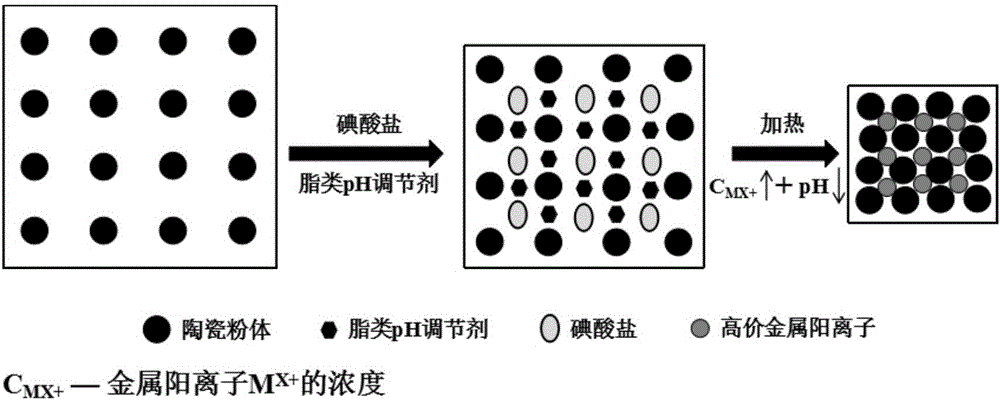Method for rapidly curing ceramic slurry
A ceramic slurry and rapid curing technology, which is applied in the field of inorganic non-metallic ceramic curing, can solve the problems of poor uniformity, long curing time, and low molding efficiency, and achieve less curing agent consumption, short curing time, and uniformity Good results
- Summary
- Abstract
- Description
- Claims
- Application Information
AI Technical Summary
Problems solved by technology
Method used
Image
Examples
Embodiment 1
[0043] 6.5g / L calcium iodate, 2.0vol% glyceryl diacetate solidified 2.0wt% tetramethylammonium hydroxide dispersed 50vol% SiO 2 slurry.
[0044] 100 grams of silica powder, 2.0 grams of tetramethylammonium hydroxide and 37.7 grams of water were mixed, and ball milled for 1.5 hours at a ball milling rate of 250 r / min to prepare a negatively charged particle surface with a solid phase volume fraction of 50%. Ceramic slurry, then add 0.54g of calcium iodate, mix and mill at a ball milling rate of 250r / min for 8 minutes, stir and degas under vacuum for 15 minutes, then add 1.66ml of glyceryl diacetate, and stir with a glass rod for 30 seconds After injection molding, place at 60°C for 20 minutes before demoulding, dry at 80°C for 12 hours, then heat up to 1250°C at a heating rate of 3°C / min for 3 hours and sinter. The relative theoretical density of the obtained ceramic dry body is 60.0%, and the shrinkage rate is 2.8%; the relative theoretical density of the obtained ceramic sin...
Embodiment 2
[0046] 7.5g / L calcium iodate, 1.5vol% triacetin solidified 0.5wt% ammonium citrate dispersed 60vol% Al 2 o 3 slurry.
[0047] Mix 100 grams of alumina powder, 0.5 grams of ammonium citrate and 16.7 grams of water, and mill at a ball milling speed of 200 r / min for 2 hours to prepare a negatively charged ceramic slurry with a solid phase volume fraction of 60%. Then add 0.6 g of calcium iodate, mix and ball mill for 10 minutes at a ball milling rate of 200 r / min, then stir and degas under vacuum for 10 minutes. Then add 1.2 ml triacetin, stir with a glass rod for 15 seconds and then inject into the mold. After being placed at 50°C for 30 minutes, it was removed from the mold, dried at 70°C for 24 hours, and then heated to 1550°C at a heating rate of 5°C / min for 2 hours for sintering. The relative theoretical density of the obtained ceramic dry body is 61.8%, and the shrinkage rate is 2.5%; the relative theoretical density of the obtained ceramic sintered part is 99.5%, and th...
Embodiment 3
[0049] 6.0g / L nickel iodate, 2.5vol% ethyl acetate curing 2.5wt% ammonium polyacrylate dispersed 55vol% SnO 2 slurry.
[0050] Mix 100 grams of tin oxide powder, 2.5 grams of ammonium polyacrylate and 16.7 grams of water, and mill at a ball milling rate of 150 r / min for 3 hours to prepare a negatively charged ceramic slurry with a solid phase volume fraction of 55%. Then add 0.50 g of nickel iodate, mix and ball mill for 10 minutes at a ball milling rate of 150 r / min, and then stir and degas under vacuum for 20 minutes. Then add 2.1 ml of ethyl acetate, stir the glass rod for 10 seconds, and inject it into the mold. After being placed at 45°C for 45 minutes, the mold was removed, dried at 80°C for 24 hours, and then heated to 1500°C at a heating rate of 10°C / min for 4 hours for sintering. The relative theoretical density of the obtained ceramic dry body is 62.3%, and the shrinkage rate is 2.6%; the relative theoretical density of the obtained ceramic sintered part is 99.6%, ...
PUM
| Property | Measurement | Unit |
|---|---|---|
| shrinkage | aaaaa | aaaaa |
| shrinkage | aaaaa | aaaaa |
| shrinkage | aaaaa | aaaaa |
Abstract
Description
Claims
Application Information
 Login to View More
Login to View More - R&D
- Intellectual Property
- Life Sciences
- Materials
- Tech Scout
- Unparalleled Data Quality
- Higher Quality Content
- 60% Fewer Hallucinations
Browse by: Latest US Patents, China's latest patents, Technical Efficacy Thesaurus, Application Domain, Technology Topic, Popular Technical Reports.
© 2025 PatSnap. All rights reserved.Legal|Privacy policy|Modern Slavery Act Transparency Statement|Sitemap|About US| Contact US: help@patsnap.com



